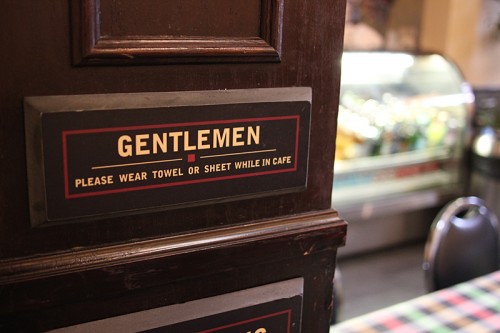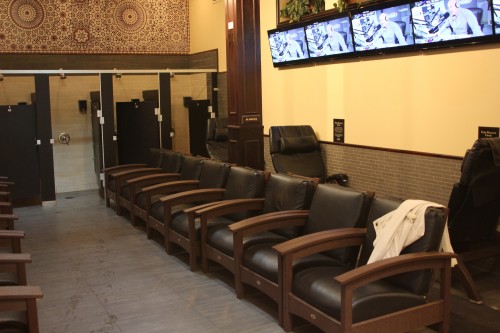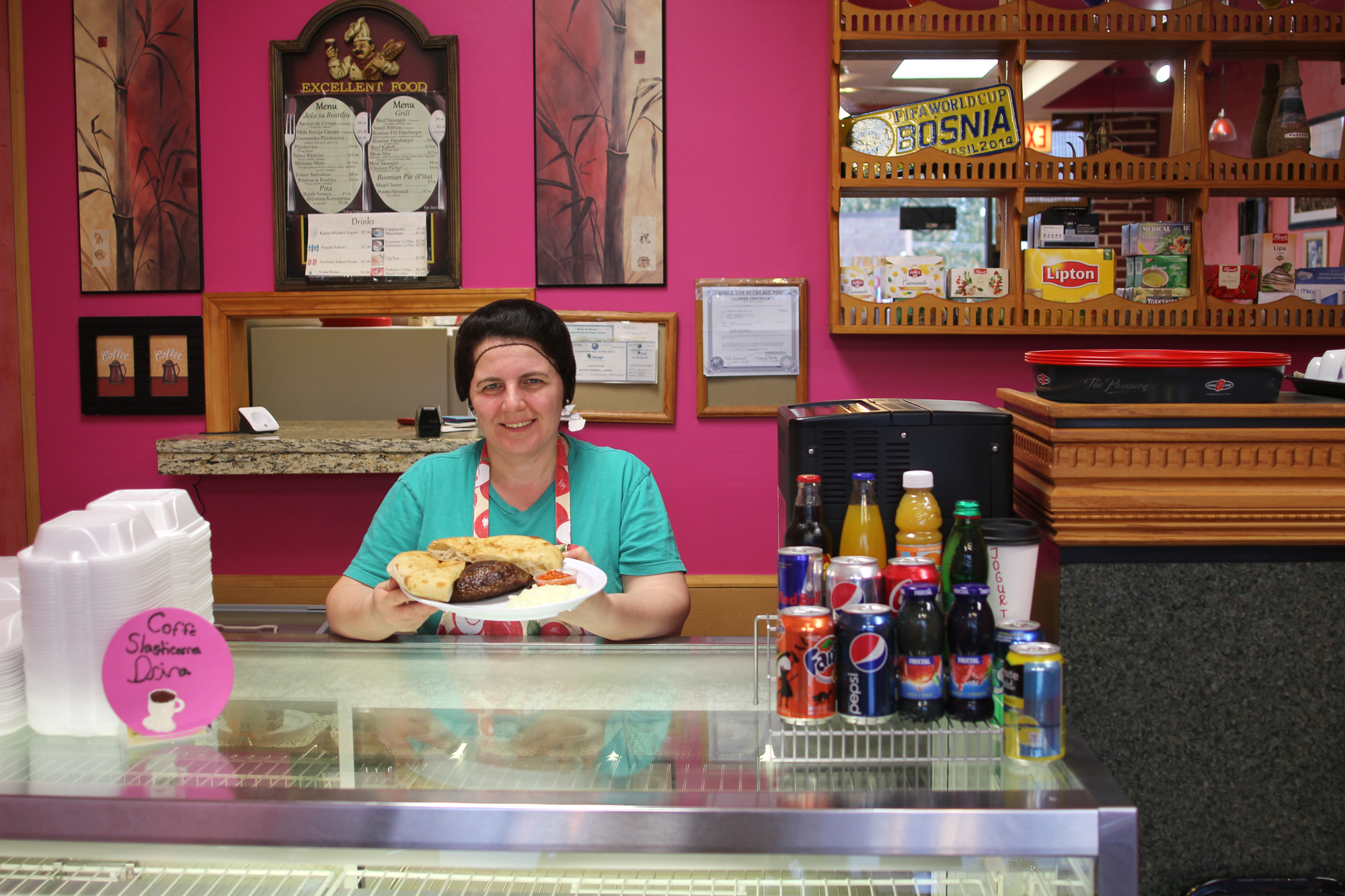THE ENORMOUS BRICK MOUND LOOKED LIKE a Neapolitan pizza oven. Also feeling like a Neapolitan pizza that just went into the oven: me, as I stumbled nearsightedly toward the wooden benches in the Russian dry sauna. I’d been warned to take my glasses off—metal, they’d soon be searing their image into the bridge of my nose in the 200-plus-degree sauna. I was warned to put a towel down before I sat on the wooden bench. I was warned not to let the brass locker key dangling from my wrist touch anything else that might be, um, dangling. The air felt like a board pressing on my chest; the room felt like a shelter on a dark planet close to the sun, one with a very thin margin for life.
Neapolitan pizza, however, was very far from being the food that I had come here for. Chicago Sweatlodge offers a male-only, authentically Russian and Turkish sauna experience in a nondescript brick building on the northwest side. And once you’ve been through that experience, it has a small café offering a variety of authentic Russian foods. Which you will eat, pink as borscht mixed with sour cream (assuming that’s roughly the color you came in with), un-selfconsciously wrapped in a towel or a skimpy robe among other pink, fleshy gentlemen.  Mention of its all-male clientele suggests a certain demographic, so to be as blunt as the “No Sex” sign on the door before you’re buzzed in: this is not a gay establishment. In fact, it’s about the most desexualized place in Chicago in almost every sense. At least on a quiet Tuesday morning, it’s maleness freed of any competition—for female attention, or for status (everyone’s wearing the same white towel velcro’d at the waist). No one’s making deals, no one’s showing off on the exercise machines (there aren’t any), no one’s even paying much attention to the TVs tuned to sports. It gets livelier on weekends, manager Bill Trotter would tell me later, when parties of Eastern Europeans come in together to hang out in the bania as if it were a 200-degree sports bar, but at this hour it seems as quiet and as removed from earthly cares as a monastery.
Mention of its all-male clientele suggests a certain demographic, so to be as blunt as the “No Sex” sign on the door before you’re buzzed in: this is not a gay establishment. In fact, it’s about the most desexualized place in Chicago in almost every sense. At least on a quiet Tuesday morning, it’s maleness freed of any competition—for female attention, or for status (everyone’s wearing the same white towel velcro’d at the waist). No one’s making deals, no one’s showing off on the exercise machines (there aren’t any), no one’s even paying much attention to the TVs tuned to sports. It gets livelier on weekends, manager Bill Trotter would tell me later, when parties of Eastern Europeans come in together to hang out in the bania as if it were a 200-degree sports bar, but at this hour it seems as quiet and as removed from earthly cares as a monastery.
I went with my friend Rob Gardner of The Local Beet, who has long had an appreciation for the schvitz experience in Jewish-American culture. “For the old guys, it was like working out, without actually having to do any exercise,” he told me. He explained the drill, starting in the very heart of Hell itself, the Russian dry sauna, centered around a massive brick mound that could have been built two thousand years ago. Sitting facing the mute stone in the twilight of the sauna, I felt like I was doing something ancient. Which, stripped of everything 21st century except a little Velcro, I was.  I took it for a few minutes, and then suddenly it was oppressive and I had to get out. At first, being outside the room, all I felt was relief. But then, like a picture developing, I felt a kind of revitalization going through me. I liked it; this crazy thing felt good. I drank a couple of glasses of water—I could have taken them inside, but within a few minutes they’d have been hot enough to make tea—and went back in.
I took it for a few minutes, and then suddenly it was oppressive and I had to get out. At first, being outside the room, all I felt was relief. But then, like a picture developing, I felt a kind of revitalization going through me. I liked it; this crazy thing felt good. I drank a couple of glasses of water—I could have taken them inside, but within a few minutes they’d have been hot enough to make tea—and went back in.
After two sessions in the dry sauna, we switched to the Turkish wet sauna. The steamy air was more welcoming, but that’s not to say you couldn’t die a horrible naked death in this room, too, signs warning not to pour so much cold water on the hot stones that the room exploded like a boiler. (This may have been Russian humor.)
By now, I felt so cooked through—a nice medium rare—that I was ready to face the sauna’s final terror: a constantly churning pool of Arctic water. I took the steps into it, and barely even felt the cold until it was chest high. I had been through it all, and I felt the place’s claims of Russian rejuvenation being proven true inside my own body, which had passed through fire and ice and grown stronger. Now there was just one more thing to do: eat.
Gallery: Inside a Russian sauna and spa
YOU THINK YOUR APARTMENT IN WICKER PARK or West Town is cramped now, but there was a time when it could have been so small you wouldn’t have even had a place to wash. Chicago built utilitarian public bathhouses in the neighborhoods around downtown to help the poor smell nicer, while Russian immigrants in early 20th century Wicker Park built fancier facilities to enjoy the steamy traditions of home. The Trenchermen restaurant occupies the site of one, and the very last survivor, the Division Street Russian and Turkish Baths, only closed in 2010 (and has subsequently been renovated into the posher Red Square sauna).
Division Street was still in a grungier Algrenesque phase of its existence when the founders of Chicago Sweatlodge used to go more than a decade ago, says Bill Trotter, the Sweatlodge’s manager. In the camaraderie of the heat, they began kicking around the idea of building a nicer, more modern version of the saunas that managing partner Ruslan Demydenko knew from his native Ukraine, and chose to convert an old industrial building in the Portage Park area because of its proximity to eastern European populations in the city and northwest suburbs.
The menu in the cafe was pretty straightforwardly American when they opened in 2007. “We had pizza, we had burgers, we had a wide range of stuff—and it was a complete flop.”
Even so Trotter, who had worked his way up through the Italian restaurant chain Leona’s, says the menu in the cafe was pretty straightforwardly American when they opened in 2007. “We had pizza, we had burgers, we had a wide range of stuff—and it was a complete flop,” he says. “Which was kind of to our surprise—we thought we would get a number of people from Eastern Europe, but it was huge. We ended up getting rid of the pizza and the burgers and backing into the menu we have now, which is items that are popular in Europe—and very little known here in most cases.”
Drinking is never far from Russian food, “and we have a wide range of beers, the usual American beers but we’ve also got a lot of beer from the Ukraine and from various parts of eastern Europe.” A shot of ice-cold vodka is a traditional chaser after your schvitz, but on this weekday morning Trotter had to rustle up a bottle of room temperature Absolut for us. Strictly speaking, you could eat here without doing the sauna, or eat first before it, but he says “usually people will do the heat first, and then eat and take it easy.”

Bill Trotter, manager of the Sweatlodge.
The food is more old-fashioned than “artisanal,” though the soups are made in house, and the pickles are made for them locally. But items like pelmeni (similar to pierogies) and chebureki (meat pies like boreks) are authentically sourced from Russian stores and wholesalers and made in the old way, and it’s simple, clean food—after the sauna, everything I taste just tastes right for my body. “For a lot of these guys, the food is home,” Trotter says. “We keep an ice cream that they have in the Ukraine, and they love that. It’s funny to see a bunch of guys in towels eating their ice cream cones.”
As calming as the place feels to the guests, there’s some serious work that goes on behind the scenes to keep the homefires burning. The brick ovens in the saunas are each loaded with 5,000 pounds of river rocks, and the gas fires are turned on overnight to heat them up, which is enough to hold the temperature in the saunas for a full day. Once a year, the sauna shuts down for a week. It takes four full days for the ovens to cool; then, terrifyingly, someone has to climb inside, pass the old basketball-sized rocks out, and put new ones in, as well as perform whatever other masonry repairs the ovens require.

Not kidding.
The men-only aspect of the business was carried over from their observations of Division Street—”They had a men’s side and a women’s side, and the only side that did any business at that time was the men’s side,” Trotter says. “When we opened this place, because of the size we made it for men only. We tried having a women’s day, but it wasn’t successful because it was so isolated from the rest of the schedule.”
“It’s all about detoxification,” Trotter says. “In Russia and the Ukraine, they’re religious about going to the bania every week. They grow up that way, they go with a group of friends, they go every Sunday. And what we see here is that it’s not just the sauna, but the culture itself is really where these guys bond, they talk, they discuss stuff, they drink a little bit and they laugh. It’s more than just getting some heat. When people come here, I always suggest they come with a friend, because you can sit, you can have something to eat, you’ll really have a relaxing day.”
Michael Gebert is the editor, usually clothed, of Fooditor.
Latest
Join the Discussion
After you comment, click Post. If you're not already logged in you will be asked to log in or register with Disqus.



















Well timed article, seems like everybody needs a schvitz these days.
[…] A Portage Park sauna enables you to chase your schvitz with borscht, or vice versa. Fooditor explores the Chicago Sweatlodge. […]